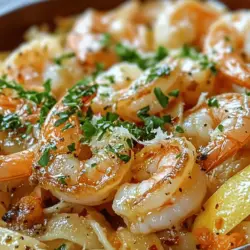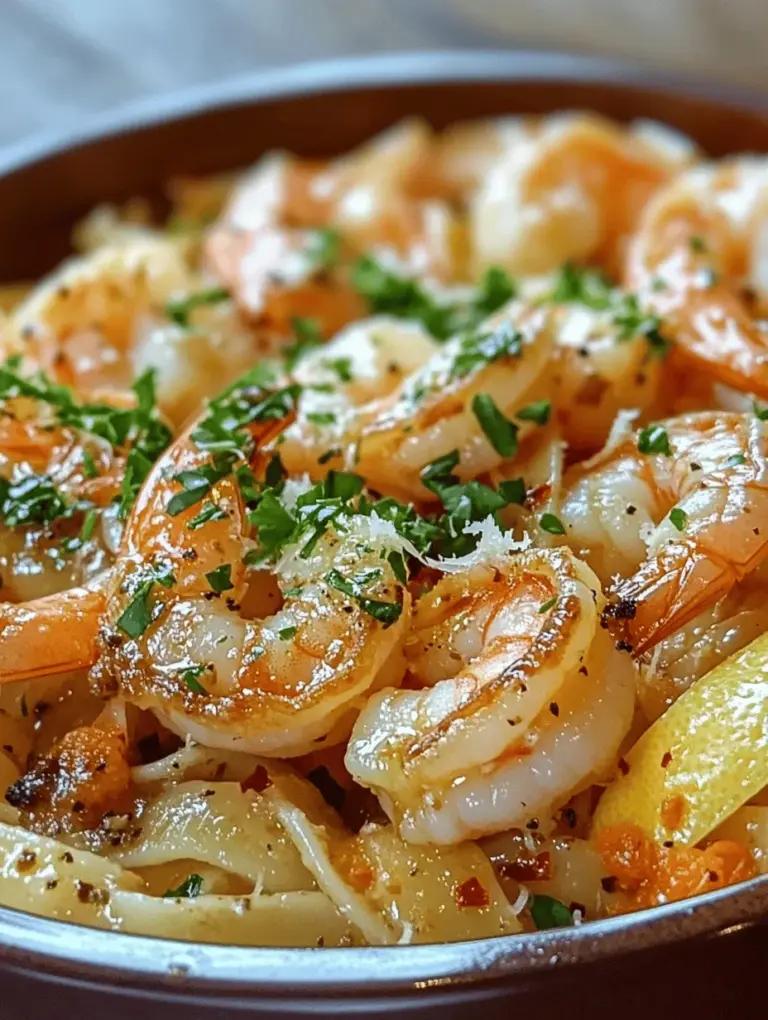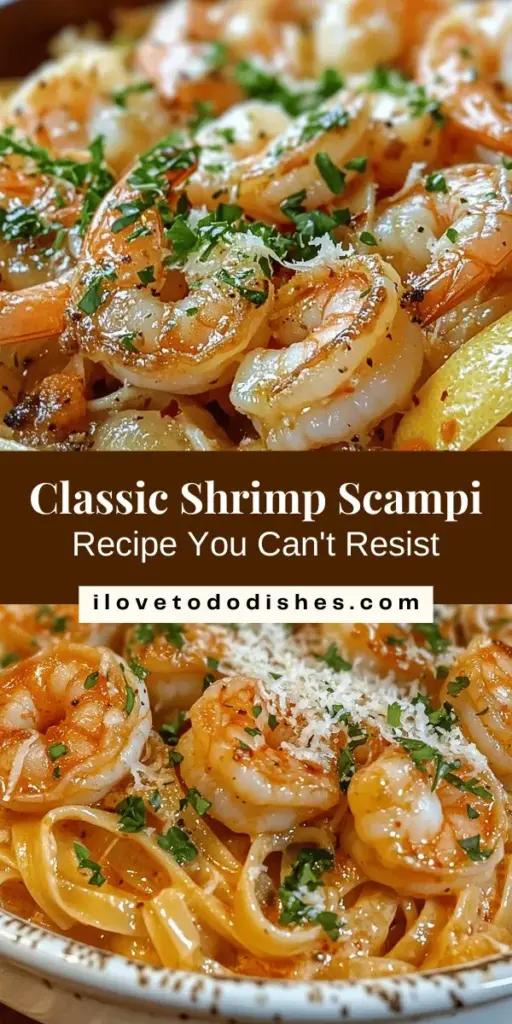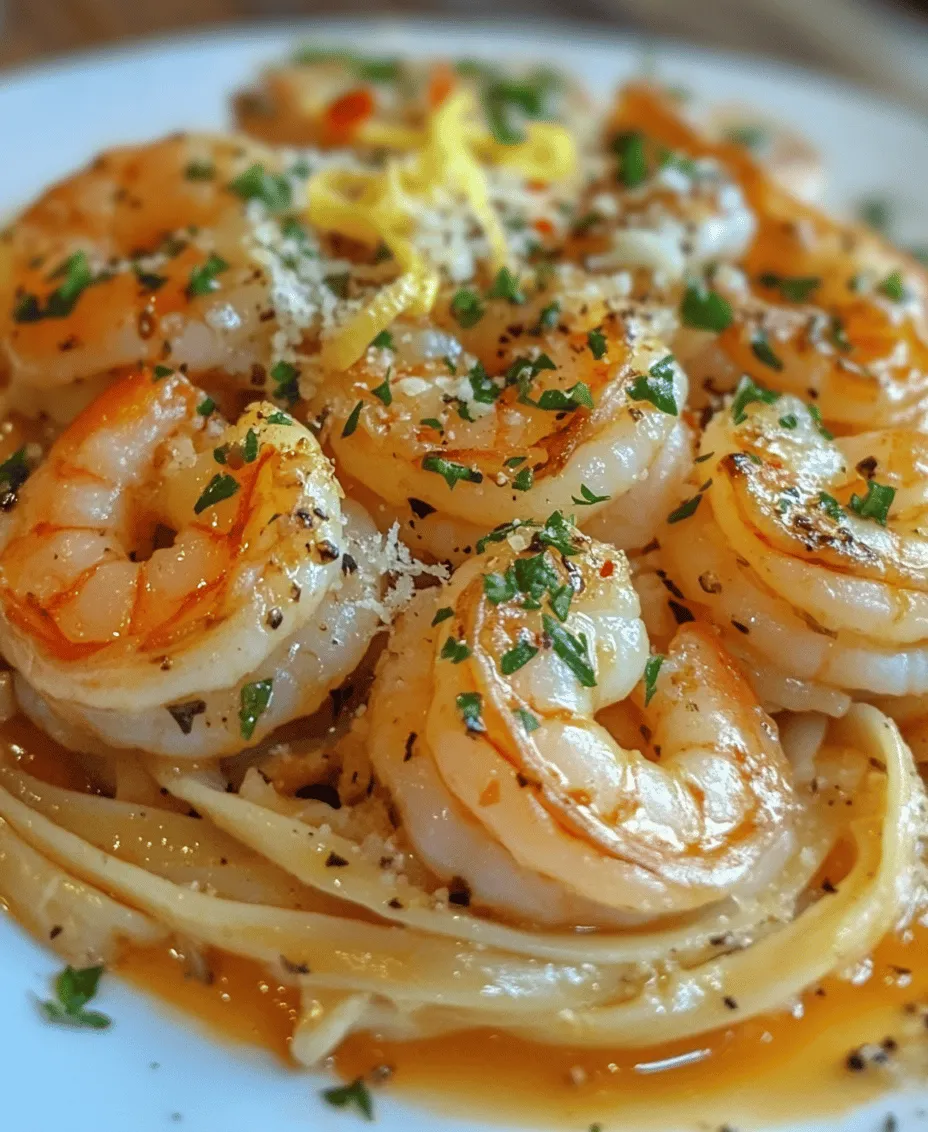Introduction
Shrimp scampi is a timeless dish that embodies the essence of Italian-American cuisine. This classic recipe features succulent shrimp sautéed in a rich, buttery garlic sauce and is served over perfectly cooked pasta. It’s a dish that brings together simple ingredients to create an irresistible meal that can be enjoyed on special occasions or as a comforting weeknight dinner. In this article, we will explore the origins of shrimp scampi, the essential ingredients, and step-by-step instructions to create your own delicious version at home.
The allure of shrimp scampi lies not only in its rich flavors but also in its straightforward preparation. With just a handful of ingredients, this dish transforms into a culinary masterpiece that impresses family and friends alike. Whether you’re hosting a dinner party or simply craving a satisfying meal, shrimp scampi is sure to deliver.
The Origins of Shrimp Scampi
Understanding the roots of shrimp scampi can enhance your appreciation for this dish.
Historical Background: The origins of shrimp scampi can be traced back to Italy, where the term “scampi” refers to a type of langoustine, a shellfish that resembles a small lobster. In Italy, scampi are often cooked simply, highlighting their delicate flavor. However, when Italian immigrants brought this dish to America, they adapted it to include the more readily available shrimp. This adaptation not only made the dish more accessible but also popularized it across the United States, cementing shrimp scampi as a staple in Italian-American cuisine.
Etymology: The word “scampi” comes from the Italian word for langoustine, and it signifies the dish’s roots in seafood. In the U.S., the term has evolved to describe a cooking style that features shrimp cooked in a garlic butter sauce, sometimes accompanied by white wine and herbs. This evolution showcases how culinary traditions can adapt and thrive in new environments, leading to the creation of beloved dishes.
Cultural Significance: Shrimp scampi has become a quintessential dish in many Italian-American households. Its presence on restaurant menus across the country speaks to its popularity and the comfort it provides. Families often gather around the dinner table to enjoy shrimp scampi, making it a dish associated with warmth, celebration, and connection. The simplicity of the recipe allows for variations, enabling home cooks to add their personal touch while still honoring the classic preparation.
Essential Ingredients for Irresistible Shrimp Scampi
A key factor in achieving a delightful shrimp scampi lies in using high-quality ingredients.
Shrimp: The star of the dish, shrimp, plays a pivotal role in the overall flavor and texture. When selecting shrimp, look for large, fresh shrimp—preferably wild-caught—for the best taste. Depending on your preference, you may choose between raw or cooked shrimp; however, raw shrimp will yield a juicier and more flavorful result. When buying shrimp, check for a firm texture and a mild, ocean-like smell. The most common varieties used in shrimp scampi include Gulf shrimp, Pacific shrimp, and white shrimp.
Butter and Olive Oil: The combination of butter and olive oil is essential for creating the rich, velvety sauce that coats the shrimp and pasta. The butter contributes a luxurious creaminess, while olive oil adds depth and a hint of fruitiness. Using a high-quality extra virgin olive oil can elevate the dish’s flavor profile, making it more aromatic and delicious.
Garlic: Garlic is the backbone of shrimp scampi, infusing the dish with its distinctive flavor. Fresh garlic cloves are preferred for their robust taste, but you may also use garlic powder in a pinch. Sautéing the garlic until it becomes fragrant will enhance its natural sweetness and ensure it perfectly complements the richness of the butter.
White Wine: A splash of white wine adds acidity and brightness to the dish, balancing the richness of the butter and enhancing the overall flavor. When choosing a wine, opt for a dry white wine such as Sauvignon Blanc or Pinot Grigio, which will impart a crisp note without overwhelming the dish. Always use a wine that you would enjoy drinking, as the flavor will concentrate as it cooks.
Fresh Herbs and Seasonings: Fresh herbs play a crucial role in elevating the dish’s flavor. Parsley is the most common herb used in shrimp scampi, providing a fresh, vibrant note that brightens the dish. Additionally, a squeeze of lemon juice adds acidity, helping to cut through the richness. For those who enjoy a bit of heat, a pinch of red pepper flakes can add a subtle kick without overpowering the other flavors.
Step-by-Step Instructions
Follow these detailed instructions to prepare your shrimp scampi.
Preparing the Pasta: Begin by cooking your choice of pasta—linguine or fettuccine are popular options for shrimp scampi. To achieve the perfect al dente texture, bring a large pot of salted water to a rolling boil. Add the pasta and cook according to package instructions, usually around 8-10 minutes. Be sure to reserve about a cup of pasta water before draining. This starchy water is a secret weapon for adjusting the sauce’s consistency later on.
Sautéing the Aromatics: In a large skillet, heat a combination of butter and olive oil over medium heat. Once the butter has melted, add minced garlic and a pinch of red pepper flakes. Sauté the garlic for about 1-2 minutes until it becomes fragrant and slightly golden. Be careful not to let it burn, as burnt garlic can impart a bitter flavor to your dish. This step is crucial for infusing the oil with the rich flavors of garlic and spice.
Cooking the Shrimp: Once the garlic is ready, it’s time to add the shrimp to the skillet. Ensure the shrimp are peeled and deveined for convenience. Add the shrimp in a single layer to the skillet, cooking them for about 2-3 minutes on one side until they turn pink and opaque. Flip the shrimp and cook for an additional 1-2 minutes on the other side. Take care not to overcook the shrimp, as they can become tough and rubbery. The shrimp should be tender, succulent, and infused with the garlic and olive oil mixture.
As you follow these steps, you’ll begin to see the dish come together, with the aromatic garlic and succulent shrimp creating an irresistible foundation for the rest of the recipe. In the next part of this article, we will dive into combining these elements into a cohesive dish, perfect for any occasion. Stay tuned for more detailed instructions and tips for achieving the ultimate shrimp scampi experience.
Deglazing: The Importance of Wine in Flavor Development and Technique
After you have perfectly sautéed your shrimp and aromatics, the next critical step is deglazing the pan. This technique is essential for building depth of flavor in your shrimp scampi. When you sauté shrimp, bits of food and fond (the brown bits left in the pan) develop at the bottom. These are packed with flavor and can elevate your dish significantly.
To deglaze, you need a good quality white wine, which will not only lift these flavorful bits but also add acidity and complexity to your sauce. A Sauvignon Blanc or Pinot Grigio works beautifully for this dish. Once you add the wine to the hot pan, use a wooden spoon to scrape up the fond, stirring constantly. As the wine reduces, it will concentrate the flavors and create a luscious base for your sauce. Aim to let the wine simmer for about 2-3 minutes until it has reduced by about half. This process not only enhances the taste but also gives the dish a luxurious, restaurant-quality finish.
Finishing the Sauce: Balancing Flavors with Lemon Juice and Zest
Once your wine has reduced, it’s time to finish the sauce. This is where the magic truly happens. Squeeze in the fresh juice of one lemon and sprinkle in the zest. The acidity from the lemon juice will brighten the entire dish, balancing the richness of the butter and the sweetness of the shrimp.
Consider tasting the sauce at this stage. If you feel it needs a touch more brightness, add a bit more lemon juice or zest. For an additional layer of flavor, incorporating a pinch of red pepper flakes can introduce a delightful warmth that complements the shrimp beautifully. Once you’ve achieved the perfect balance, add the sautéed shrimp back to the pan, tossing them gently to coat in the sauce. Allow everything to simmer together for another minute or so, ensuring the shrimp are heated through and well-integrated with the sauce.
Combining with Pasta: Ensuring Even Distribution of Sauce and Shrimp
Now that your sauce is finished, it’s time to combine everything with your pasta. Choose a long pasta like linguine or spaghetti, which will twirl beautifully with the shrimp and sauce. Make sure your pasta is cooked al dente according to package instructions before draining. Reserve a cup of pasta water; this will help you adjust the sauce’s consistency if needed.
Add the drained pasta to the skillet with the shrimp and sauce. Toss everything together vigorously, ensuring that each strand of pasta is coated in the rich sauce. If the mixture seems too dry, gradually add the reserved pasta water, a few tablespoons at a time, until you reach your desired consistency. This technique not only helps the sauce adhere to the pasta but also ensures a cohesive dish, maximizing the flavor in every bite.
Serving Suggestions: Presentation Ideas and Garnishing Tips
When it comes to serving shrimp scampi, presentation is key. To create an inviting plate, consider using large, shallow bowls or elegant plates. Start by twirling a nest of pasta in the center, then artfully arrange the shrimp around the pasta. Drizzle any remaining sauce from the pan over the dish for that glossy, luxurious finish.
For garnishing, freshly chopped parsley adds a pop of color and freshness. You can also grate some additional lemon zest over the top for an eye-catching and aromatic touch. If you want to take it a step further, serve with lemon wedges on the side, allowing guests to customize their dish with extra citrusy brightness.
Nutritional Information
Understanding the nutritional content of shrimp scampi can help you enjoy it guilt-free. Each serving of shrimp scampi generally contains around 400-500 calories, depending on the amount of butter and pasta used.
Caloric Breakdown: Analysis of Calories Per Serving
– Shrimp: Low in calories and high in protein, a 4-ounce serving of shrimp contains approximately 120 calories.
– Pasta: A typical serving of pasta adds about 200 calories.
– Butter and Olive Oil: Each tablespoon of butter contributes about 100 calories, while olive oil contains about 120 calories per tablespoon.
Overall, a serving of shrimp scampi can fit well within a balanced diet, especially when paired with a side of vegetables or a light salad.
Health Benefits of Shrimp: Discussing the Protein and Omega-3 Content
Shrimp is an excellent source of lean protein, making it a great choice for those looking to maintain muscle mass or lose weight. A 4-ounce serving of shrimp contains about 23 grams of protein, essential for muscle repair and growth. Additionally, shrimp is rich in omega-3 fatty acids, which are beneficial for heart health and reducing inflammation. These healthy fats also contribute to brain health and cognitive function.
Modifications for Dietary Needs: Suggestions for Gluten-Free or Low-Calorie Versions
For those with dietary restrictions, shrimp scampi can be easily modified. To make it gluten-free, substitute regular pasta with gluten-free pasta options made from rice, quinoa, or legumes. For a low-calorie version, consider reducing the amount of butter used or replacing it with a light olive oil for sautéing. You can also opt for zucchini noodles (zoodles) or spaghetti squash as a low-carb alternative, maintaining the dish’s fresh flavors while cutting down on calories.
Pairing Shrimp Scampi with Wine
Choosing the right wine can elevate your dining experience and complement the rich flavors of shrimp scampi.
Recommended Wines: Suggestions for White Wine Pairings
A classic pairing for shrimp scampi is a chilled glass of white wine. Here are some excellent choices:
– Sauvignon Blanc: Its acidity and citrus notes enhance the lemony flavors in the dish.
– Pinot Grigio: This wine’s crispness and light body make it a refreshing companion.
– Chardonnay: A lightly oaked Chardonnay can add richness that complements the butter in the sauce.
Feel free to serve the same wine you used for deglazing the pan; this creates a harmonious dining experience.
Non-Alcoholic Options: Alternatives for Those Who Prefer Not to Drink
If you or your guests prefer non-alcoholic options, consider serving sparkling water with a slice of lemon or a non-alcoholic white wine. Herbal iced teas with a hint of citrus can also provide a refreshing palate cleanser that pairs well with the flavors of the dish.
Variations of Shrimp Scampi
While traditional shrimp scampi is undeniably delicious, there are countless ways to put a creative twist on this classic dish. Here are some variations to consider:
Creamy Shrimp Scampi: Adding Cream for a Richer Sauce
For those who enjoy a creamier sauce, simply incorporate heavy cream or half-and-half into your finished sauce. Start with about 1/2 cup, adding it after deglazing the pan and before adding the shrimp back. This will give you a rich sauce that coats the pasta beautifully.
Spicy Shrimp Scampi: Incorporating Different Spices for Heat
To bring some heat to your dish, consider adding crushed red pepper flakes or diced jalapeños to the sautéed garlic and shrimp. Adjust the spice level to your liking, keeping in mind that a little goes a long way. You can also experiment with different spices, such as cayenne or smoked paprika, for added flavor complexity.
Vegetable Additions: Suggestions for Enhancing Nutritional Value
Adding vegetables to shrimp scampi can enhance its nutritional value and add texture. Consider sautéing some spinach, cherry tomatoes, or asparagus alongside the shrimp. These additions not only provide vibrant color but also boost the dish’s fiber and vitamin content.
Conclusion
Shrimp scampi is a dish that captures the hearts and palates of many, combining rich flavors and satisfying textures in every bite. By following this recipe and understanding the nuances of preparation, you can recreate this classic meal in your own kitchen. Whether enjoyed on a special occasion or as a comforting weeknight dinner, shrimp scampi is sure to impress and delight everyone at the table. With its versatility and endless variations, you can personalize it to suit any taste preference or dietary need, ensuring that this dish remains a favorite for years to come. So roll up your sleeves, gather your ingredients, and get ready to indulge in this timeless culinary delight.



